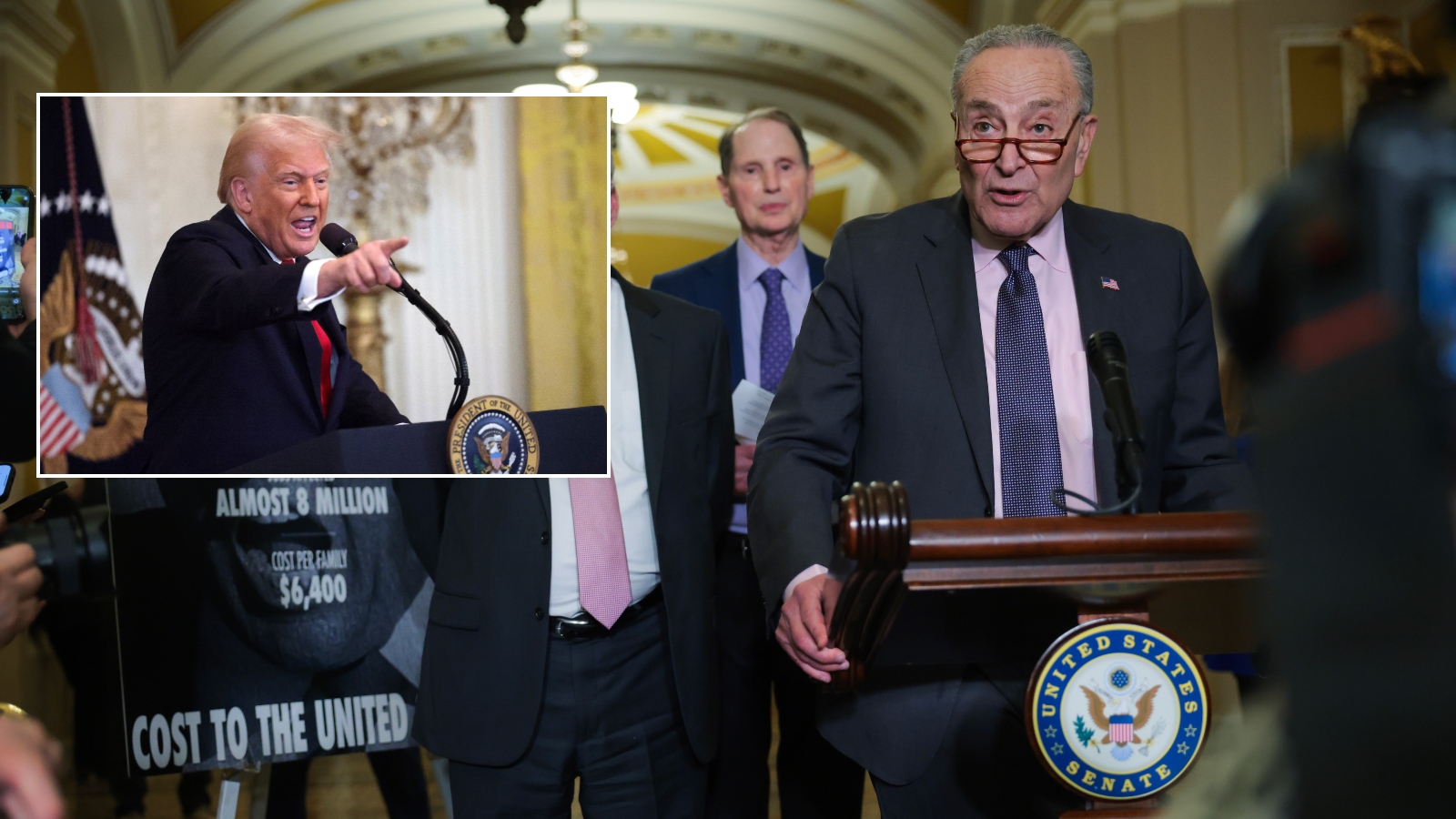NOTE:VIDEO AT THE END OF ARTICLE.
Former CNN political analyst Chris Cillizza offered a sober assessment on Friday regarding the formidable challenges Democrats face in their bid to retake the Senate in 2026—even in the event that President Donald Trump’s global tariff policy triggers significant economic fallout.
In a detailed discussion during a livestream, Cillizza addressed a viewer’s question about whether the potential negative economic repercussions from Trump’s sweeping tariffs could create an opening for Democrats in the Senate race. Despite the possibility that tariffs might cause market instability, Cillizza argued that the electoral landscape remains extremely difficult for Democrats.
Tariffs, Turbulence, and the Political Battlefield
Markets experienced a sharp downturn on both Thursday and Friday following President Trump’s announcement of broad-based tariffs designed to exert pressure on key international partners. While some economists have warned that these measures could backfire, inflicting serious damage on the U.S. economy, Cillizza maintained that even if the worst occurs, it would not translate into the kind of political advantage that Democrats need in the upcoming 2026 Senate contests.
According to Cillizza, Democrats require a net gain of four seats to secure a majority. This mathematical necessity is compounded by structural challenges on the ground. “They need to net four seats, okay, because JD Vance is the vice president, the president of the Senate breaks ties, so you got to have a clear majority if you’re Democrats,” he explained. Cillizza further pointed out that even if Democrats were to hold onto their current seats, they still face a steep uphill battle in states that are heavily red, where 21 of the 22 open seats are located—states that Trump won in the last presidential election.
The analyst underscored that the only district that might offer a more favorable battleground is in Maine, where the incumbent is Susan Collins, a senator in a state won by former Vice President Kamala Harris. However, even this situation appears challenging, as Collins is expected to be a significant target for Democratic challengers.
Analyzing the Electoral Map: The Challenges Ahead
Cillizza’s analysis extends to a broader examination of the Senate map. He cited North Carolina as an example, noting that incumbent Republican Senator Thom Tillis is expected to face a competitive race, potentially against a strong Democratic candidate like former Governor Roy Cooper. “I could see that being a real race because I think Roy Cooper, the popular former Democratic governor, is probably going to run. So I think that that’s a race,” he remarked. However, Cillizza warned that the overall picture remains bleak for Democrats.
He elaborated on the broader challenges by walking through a list of red states that would have to be won. “They need four,” Cillizza emphasized, “So let’s assume they don’t lose any of their own, which, look, Georgia is going to be a big race for Democrats, so is Michigan, Minnesota and New Hampshire maybe, but Georgia and Michigan are going to be huge, huge races that they’d have to hold.” When pressed to identify additional potential gains, he mentioned Ohio—where John Husted currently holds an appointed Senate seat—as a possibility, though Ohio’s difficult political climate renders it a long shot.
Cillizza proceeded to review, in an almost alphabetical fashion, a series of states including Alaska, Alabama, Arkansas, Florida, Iowa, Idaho, Kansas, Kentucky, Louisiana, Mississippi, Montana, Nebraska, Oklahoma, South Carolina, South Dakota, Tennessee, Texas, West Virginia, and Wyoming. “I mean, Iowa’s probably the best bet there, maybe Florida. It’s just the map is not great for them. It just isn’t for Democrats,” he observed.
These comments highlight the overarching difficulty: even if Democrats managed to secure a win in Maine and North Carolina, their path to a Senate majority remains obscured by a multitude of competitive races in states that have traditionally leaned Republican.
The Tariff Question: Economic Fallout Versus Electoral Gains
During the livestream, a viewer inquired specifically whether the potential for economic harm—if Trump’s tariffs were to backfire as some economists predict—might tip the scales in favor of Democrats. In response, Cillizza outlined why such an outcome is unlikely to be decisive.
He argued that while economic downturns can sometimes alter voter behavior, the regions that would need to swing in favor of Democrats are overwhelmingly unfavorable. “It starts to get dicier after that,” he noted, explaining that even if economic factors were to hurt the incumbent party nationally, the local dynamics in many red states would still pose insurmountable challenges. In his view, the prospect of gaining four additional Senate seats by capitalizing on economic discontent in these states is highly improbable.
Cillizza’s assessment implies that the potential economic backlash from tariffs would have to be extraordinarily severe to overcome the entrenched partisan loyalties in these states—a scenario that, in his judgment, remains unlikely.
Internal Party Dynamics and the Call for New Leadership
Beyond the macroeconomic and geographic hurdles, Cillizza pointed to mounting dissatisfaction within the Democratic Party as another factor undermining their Senate ambitions. He recalled how Democratic Senator Jeanne Shaheen of New Hampshire announced her decision not to seek reelection, a move followed by similar retirement announcements from Senators Gary Peters of Michigan and Tina Smith of Minnesota. These retirements, Cillizza warned, have already dampened the hopes of Democrats who aimed to regain control of the Senate in 2026.
In addition, Senate Minority Leader Chuck Schumer has come under increasing fire from within his own party. After his decision last month to support a months-long continuing resolution aimed at funding the government—an effort that aligned him with Republican priorities—calls for his ouster have intensified. The prospect of a leadership challenge has grown, with some Democratic strategists even suggesting that a primary contest against a figure like Representative Alexandria Ocasio‑Cortez (AOC) could prove decisive. AOC, nearly 40 years younger than Schumer and emblematic of a new progressive generation, has been floated as a potential candidate to reshape the party’s future.
Cillizza’s commentary thus fits within a broader narrative of a party at a crossroads. The combination of unfavorable electoral maps, economic uncertainties, and internal dissension suggests that the Democrats’ chances to retake the Senate are more precarious than many of their supporters might hope.
The Broader Implications for the 2026 Senate Elections
The challenges outlined by Cillizza extend beyond any single race or issue. Instead, they paint a picture of a deeply divided electoral landscape where traditional Republican strongholds dominate, and the room for swing seats is limited. The current configuration of the Senate map suggests that, even under optimal conditions, the Democrats would need extraordinary circumstances to flip the balance of power.
Moreover, the mounting criticism of Schumer’s leadership indicates that the struggle for control of the Senate may involve more than just the typical partisan battles. The internal pressure for new leadership—exemplified by discussions around a potential primary challenge from AOC—reflects a broader dissatisfaction among Democrats with the current establishment. Such a challenge, while fraught with its own risks, could force a reckoning that might reshape the party’s approach in future elections.
As political analysts like Mark Halperin have noted, the stakes are high. Even if economic factors related to tariff backlash were to hurt Republican voters, the necessary swing states remain highly unfavorable for Democrats. With competitive races in key battlegrounds such as Georgia, Michigan, and potentially Ohio, the Democrats face a long and difficult journey if they hope to secure the four additional seats required for a Senate majority.
In addition, the potential leadership crisis involving Schumer adds an extra layer of complexity. Should Schumer be forced to step down—either voluntarily or as a result of a primary challenge—the transition could introduce further uncertainty. Leadership changes often come with internal reorganization and periods of adjustment, which may weaken the party’s overall performance in a general election.
Assessing the Path Forward: Strategic Considerations
Looking ahead to the 2026 Senate races, several strategic imperatives emerge for the Democratic Party. First, there is a clear need to identify and cultivate candidates who can perform well in highly competitive and traditionally Republican-leaning states. Given the current map, the party must focus its resources on a handful of key battlegrounds where even a modest shift in voter sentiment could yield a crucial seat.
Second, the party’s messaging must address both national economic concerns and local issues. While Trump’s tariff policy might generate some voter discontent, the Democrats will need to offer clear, actionable alternatives that resonate with voters in red states. This means articulating a vision that not only contrasts with Republican policies but also addresses the real economic challenges faced by ordinary Americans.
Third, internal party dynamics must be managed carefully. The debate over leadership—particularly concerning figures like Schumer—illustrates that voter enthusiasm for change may not solely be about policy, but also about a desire for a new generation of leadership. Balancing the call for fresh faces with the need for experienced political operators will be one of the party’s most significant challenges in the coming years.
Political figures such as former pollster Mark Penn have warned that a high-profile challenge to Schumer, particularly from a progressive candidate like AOC, could have profound consequences. Penn cautioned that such a contest might drive away moderates and further depress Democratic ratings, potentially leading to a scenario in which the party’s base becomes isolated. This internal friction could weaken the party’s overall electoral prospects, making it even harder to capture the additional Senate seats needed for a majority.
Conclusion: A Cautious Outlook for 2026
In summary, former CNN political analyst Chris Cillizza’s remarks offer a cautionary perspective on the Democrats’ prospects in the 2026 Senate elections. Even if President Trump’s tariff policies trigger significant economic fallout, the complex electoral map, compounded by internal party challenges and a shifting leadership landscape, suggests that the Democrats face steep odds in their pursuit of a Senate majority.
Cillizza’s analysis, which highlights the difficulty of flipping seats in states that heavily favor Republicans, underscores the formidable obstacles that lie ahead. With key battlegrounds in states such as Georgia, Michigan, and Ohio, and with the possibility of an internal leadership crisis centered around figures like Chuck Schumer, the path for the Democrats is fraught with challenges.
For the Democratic Party to overcome these hurdles, it will need to adopt a multifaceted strategy that addresses local electoral realities, articulates compelling economic alternatives, and navigates the turbulent waters of internal dissent. Only by doing so can the party hope to secure the critical four-seat swing required to retake the Senate and forge a new path forward in American politics.
As the 2026 election cycle approaches, political observers and party insiders alike will be watching closely to see how these dynamics play out. The coming years promise to be a period of significant transformation, with the potential to reshape not only the Senate but also the broader future of the Democratic Party. In this challenging environment, the balance between economic policy, electoral strategy, and leadership renewal will be key to determining whether the party can mount a successful comeback in one of the nation’s most critical political arenas.
This analysis provides an in-depth look at the challenges facing the Democratic Party in the 2026 Senate races, drawing on insights from former CNN analyst Chris Cillizza and incorporating broader considerations of electoral dynamics, economic policy, and internal party leadership. As the political landscape evolves, these factors will play a critical role in shaping the future of American governance.

Adrian Hawthorne is a celebrated author and dedicated archivist who finds inspiration in the hidden stories of the past. Educated at Oxford, he now works at the National Archives, where preserving history fuels his evocative writing. Balancing archival precision with creative storytelling, Adrian founded the Hawthorne Institute of Literary Arts to mentor emerging writers and honor the timeless art of narrative.
